Strawberry IPM Newsletter No. 1- May 23, 2022
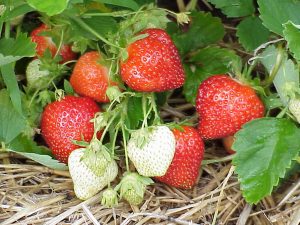
Strawberry IPM Newsletter No. 1- May 23, 2022
Click on photos to enlarge
2022 STRAWBERRY PEST MANAGEMENT SEASON BEGINS
Vegetable and Berry Growers Twilight Meeting at Bell’s Farm, Auburn, on June 7, 2022, at 6 p.m.
Situation:
Strawberry development this spring started off near normal, but recent hot weather has pushed blossom and insect emergence in most fields. Winter injury has been observed in many fields, mostly in low areas, where mulch was blown off of the plants, but the damage has not been severe. Early flowering varieties such as Wendy, are showing a few blossoms to nearly full bloom in matted rows, depending on location. Growers using plasticulture and row covers may have plants in bloom to green fruit. There has been some frost injury noticed on early varieties, but nothing severe. No frost warnings for the next week, but growers should still be vigilant and be prepared to frost-protect their plants, if necessary.
Unfortunately, with COVID still with us, we should continue to follow CDC Guidelines to reduce its impact on your staff and customers. If you need a refresher in best practices for managing pick-your-own and producing sales under these conditions, there are several resources available. Cornell University has published a very helpful guide: “Best Management Practices for U-Pick Farms During the COVID-19 Pandemic”. The Maine Department of Agriculture, Forestry and Conservation, has published an addendum of Maine-specific regulations and suggestions. Free downloads of the publications are available here:
We have begun scouting strawberry fields for overwintering insect pests, disease issues, and winter injury. The results of our strawberry scouting will be reported through this newsletter until harvest time. You can also get quick access to this information through the UMaine Highmoor Farm news blog or the UMaine Pest Management web page. If you have questions about the Newsletter, please give us a call at 933.2100 or send an e-mail message to me at:
Spring Growers’ Twilight Meeting
The Maine Vegetable & Small Fruit Growers Association will be having a Spring Twilight Meeting on Tuesday, June 7, at 6 pm at Bell’s Farm, 1552 Riverside Drive in Auburn. The Dave and Ray Bell specialize in potatoes and sweet corn, but also grow a wide variety of vegetables for their stand. They supply many large groceries in the area and have a sophisticated packing line for their fresh corn. We will also have Glen Koehler from the Pest Management Office at the meeting to discuss recent concerns about PFAS chemicals in pesticides and what this means to growers in Maine.
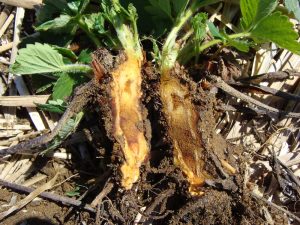
Winter injury:
Plants may be victims of winter injury if they appear weak or dead: especially in more exposed parts of a field, where mulch was not applied or where mulch was displaced by wind or animals. This is caused by freezing of the tissue in the crown of the plants, and therefore can be diagnosed by cutting into the crowns of the strawberry plants. The internal tissue will show dark brown discoloration. To reduce the impact of winter injury, make sure the plants get plenty of water and apply nutrients to encourage root growth and flower development, which should include: nitrogen, calcium, and phosphorus. Heavy nitrogen fertilizer applications in the spring are not recommended, but up to 20 pounds of actual N (e.g. 125 lb. calcium nitrate) may improve early spring growth.
Spring Weed Management:
Some growers were not able to make their typical dormant fall herbicide applications due to the early snowfall. Herbicides available for spring applications are much more limited due to concerns about plant injury and harvest intervals. Dacthal® and Devrinol® herbicides are registered for use in the spring and can be very effective on annual grasses and some broadleaf weeds, but only have pre-emergent activity, i.e. will not control weeds already emerged. Other herbicides have some post-emergent activity but may only be applied with a shielded sprayer to the areas between the plant rows, not directly over the plants, or injury is likely to occur. These materials include Chateau®, Prowl H2O®, Satellite Hydrocap®, and Aim®.

Two-spotted spider mites:
I have found mites in nearly all fields we’ve scouted this spring. Populations have been very high in some cases, especially where the plants were under row covers for the winter and/or early spring. Mites reproduce rapidly when warm weather arrives, so it is important to scout for them regularly. Spider mites mostly feed on the undersides of strawberry leaves. Infested leaves will develop yellow flecking and a bronzed appearance, and the plants become weakened and stunted. Fields that have had excessive nitrogen fertilizer and/or row covers tend to be most susceptible to mite injury. To scout for mites, collect 60 leaves from various locations in the field and examine the undersides for the presence of mites. Mites are very small – you may need a hand lens to see them. Chemical control options for two-spotted spider mites include Acramite®, Portal®, Nealta® Savey®, Zeal®, Vendex®, Oberon®, Brigade®, Danitol®, and JMS Stylet Oil® (oils will cause plant injury if used in combination with captan or within 14 days of an application of sulfur).
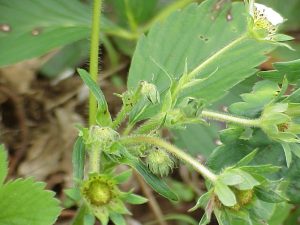
Strawberry bud weevil:
There has been some damage from “clippers” observed this week. Affected flower buds are clipped below the base and dangle from their stems looking wilted and brown. The small weevil that causes the damage can often be found amongst the flower clusters, laying eggs and feeding on pollen. Once the buds have opened these insects no longer cause significant injury. Clippers have been active in some fields that we’ve scouted, but some early fields are already beyond the bud stage where the clipper can cause damage. The control threshold for clipper injury is more than 1.2 clipped buds per two feet of row. Small holes in the petals of opening flowers indicate clipper feeding activity and are often first noticed in the border rows. Expect clipper damage to be most common in later blooming varieties now beginning to flower. Insecticide options for clippers include Lorsban®, Brigade®, Bifenture®, Danitol®, Sevin®, and PyGanic®. Clippers will also attack the buds of raspberries and blackberries, although they do not usually cause significant injury.
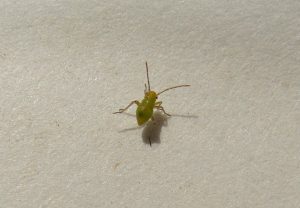
Tarnished plant bug activity has also been noted this week, with both adult and nymph stages present in some fields, but none yet over the control threshold. The nymphs can be hard to find, especially if the plants are wet. Young nymphs are very small (2 mm), active, yellow-green insects. It is important to scout for them regularly, as they may appear very quickly as the weather improves. The threshold for plant bug nymphs is 4 or more flower clusters infested per 30 sampled. You don’t have to count the nymphs; just tap flower clusters over a plate or tray to knock any nymphs off. If any appear on the plate after tapping, count that cluster as “infested”. Start scouting any field with open flowers now. Insecticide options for tarnished plant bugs include malathion, Assail®, Brigade®, Bifenture®, Dibrom®, Danitol®, and PyGanic®.
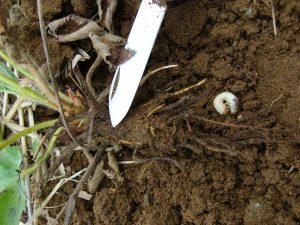
White grubs:
Weak growth noted in fields this spring may also be the result of white grubs feeding on the roots of newer plantings. These grubs are the larvae of beetles, including European chafer and Asiatic garden beetle. They differ from the larvae of black vine weevil and strawberry root weevil in that they have legs and a swollen anterior (rear end), and they tend to be larger. Their feeding weakens the plants by reducing the number of roots. The grubs can be found by pulling up weak plants and sifting through the soil that surrounds the roots. Controlling white grubs once they have become established in a field can be difficult. These tend to be more of a problem in new fields that have been planted following a grass rotation crop because the adults prefer to lay their eggs in sod. Admire Pro® and Platinum® insecticides are labeled for control of white grubs and should be applied within two hours of irrigation or rainfall to be sure the chemical gets into the root zone. Admire Pro® requires a 14-day harvest interval, while Platinum® requires a 50-day pre-harvest interval.

Diseases:
Bloom is a critical time to protect strawberry fruit against gray mold caused by the fungus Botrytis cinerea, especially when conditions have been damp. Two to three sprays of fungicide during bloom are typically required to provide good protection against this disease. Botrytis cinerea overwinters on old leaves and plant debris. Fruit infections take place almost exclusively through the flowers, so gray mold control efforts must be focused on the bloom period. If the bloom period is dry and/or good fungicide coverage is maintained, the incidence of gray mold at harvest should be low.
There are several excellent fungicide choices for control of gray mold in strawberries. Elevate® (fenhexamid) has good to excellent activity against Botrytis. Captevate® is a pre-mix of captan and fenhexamid and has a broader spectrum of activity than Elevate® alone. Switch® (cyprodinil and fludioxonil), Scala® (pyramethanil) and Pristine® (pyraclostrobin and boscalid) are also excellent products for gray mold control. Topsin M® + captan is also a good fungicide combination, but remember that captan is strictly a protectant and can be washed off by rain or irrigation water. Thiram is similarly effective, but also susceptible to wash-off.
The fungicides Cabrio® (pyraclostrobin) and Abound® (azoxystrobin) are NOT suitable for gray mold control but are effective against anthracnose and other fruit rot and leaf spot diseases. All fungicides mentioned above have a 0-day pre-harvest interval, except Topsin M® (1 day) and thiram (3 days). Remember to alternate fungicides with different modes of action for resistance management purposes.
Highbush blueberries are showing some winter injury on last year’s growth. This appears as a dark brown or black discoloration on the shoots. The damage is usually limited to growth above the snowline.
2022-2023 New England Small Fruit Management Guides The latest edition of the Guide is available online
A printed version of the guide is now available through our office. The cost of the Guide is $25, including shipping. You can request a copy by sending a check made out to “Cooperative Extension” to the Highmoor Farm address below. Members of the Maine Vegetable & Small Fruit Growers Association will receive a copy as a benefit of membership.
The best way to manage strawberry pests is to scout your own fields regularly and often. You should begin to scout as soon as flower buds emerge from the crowns and continue to monitor the plantings one or two times per week up until harvest.
Sincerely,
David T. Handley
Vegetable and Small Fruit Specialist
Highmoor Farm Pest Management Unit
P.O. Box 179 17 Godfrey Dr.
Monmouth, ME 04259 Orono, ME 04473
207.933.2100 1.800.287.0279
Where brand names or company names are used, it is for the reader’s information. No endorsement is implied nor is any discrimination intended against products with similar ingredients. Always consult product labels for rates, application instructions and safety precautions. Users of these producers assume all associated risks.
The University of Maine is an equal opportunity/affirmative action institution.
